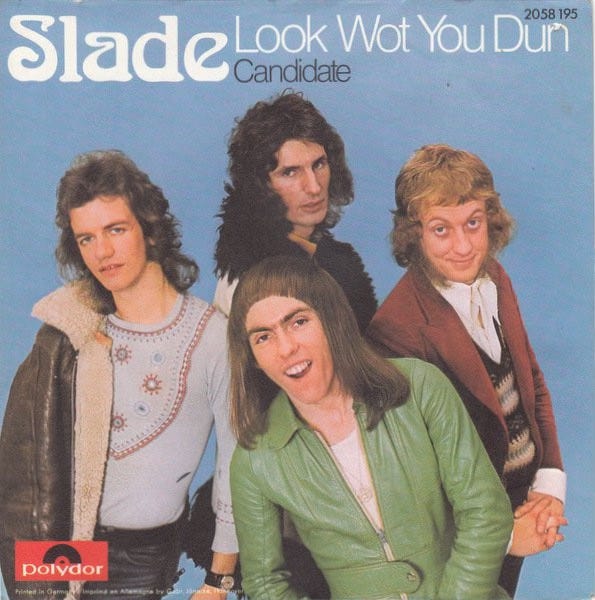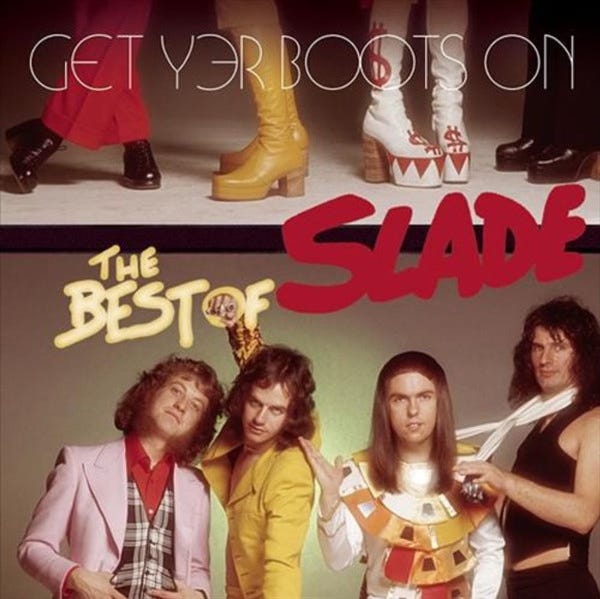Goin' Crazee with Noddy Holder (Part 1)
Flashing back on my extensive 2003 interview with Slade's foghorn-voiced frontman
“Hello,” I said to the person on the other end of the transatlantic phone call, who had just picked up the phone with an unintelligible grunt. “May I please speak to Noddy Holder?”
“This is HEEEEEEE,” the voice responded, hissing like a particularly insouciant snake. It was all I could do not to drop my phone and squeal with excitement like a little girl…
The occasion of our interview was a compilation album I was producing at the time called Get Yer Boots On: The Best of Slade. Released by Shout! Factory in March 2004, the CD contained the UK band’s 16 biggest hits, all of which had already appeared many times over on various Best-Ofs and Greatest Hits comps. What was novel about Get Yer Boots On was the fact that no Slade compilation had ever been released in the US before on CD; and as a bonus, British national treasure Noddy Holder — he of the voluminous red sideburns and the voice that could peel plaster off of the side of a house — had kindly agreed to comment on each track for our CD’s liner notes.
Even more so than their contemporaries T.Rex, Slade were absolutely massive in the UK but couldn’t get arrested in the US. T.Rex at least had a #10 hit in 1971 with “Bang a Gong (Get It On), but Slade never managed to crack the US charts in a meaningful way until 1984’s “Run Runaway” (whose Stateside release was greased by Quiet Riot’s recent success with a cover of “Cum On Feel the Noize”) hit #20. But from 1971 to 1975, Slade absolutely ruled the UK and European charts with one boot-stomping, rafter-raising singalong after another, lodging 12 straight singles in the UK Top 5, half of which went all the way to Number One.
In Noddy Holder, Slade boasted a charismatic frontman with an instantly identifiable voice and considerable rhythm guitar chops, but the Black Country-spawned band was truly a team effort. Jim Lea, who played bass, guitar and keyboards and was also a classically trained violinist, formed a prolific Lennon/McCartney-like songwriting partnership with Noddy. Dave Hill may have sported the worst haircut in rock n’ roll, but his flamboyant stage presence and a simple-but-creative lead guitar style more than made up for it. And behind the kit, Don Powell kept things stomping with some powerful but decidedly non-fussy pounding. With their raucous energy, catchy choruses, brash working-class humor (which, among other things, manifested in the phonetic — and at the time somewhat controversial) spelling of many of their song titles) and eye-popping fashion choices, Slade gleefully stood out against the drabness of early-seventies Britain, their music and personas influencing and anticipating the punk movement that followed in their stack-heeled footsteps just a few years later.
My interview with Noddy was an absolute delight, and I was absolutely overjoyed the other week upon unexpectedly unearthing the long-lost mini-cassette recording of our 90-minute chat. While certain quotes from the conversation did appear in the liner notes of Get Yer Boots On, the bulk of this interview transcript has never appeared anywhere before — and as with my previously unpublished-in-full Q&As with the likes of Esquivel, Cheech Marin, AC/DC’s Angus Young, Dave Davies of The Kinks, Eddie Money and Lemmy Kilmister of Motörhead, I’m making it available for my paid subscribers to read and enjoy.
This interview is a long one, and will run in three or maybe even four parts. If you’re a Slade fan who’s on the fence about subscribing to Jagged Time Lapse, be advised that Slade will also be the topic of the next episode of CROSSED CHANNELS, the podcast in which my English friend and fellow Substack scribe Tony Fletcher and I discuss artists from the US and UK who had vastly different experiences on their opposite side of the pond. Our monthly episodes are all available in full to anyone who subscribes to either of our Substacks.
Subscribers to Jagged Time Lapse also get to read chapters from the memoir I’m writing around the musical soundtrack to my tumultuous adolescence, which include such momentous recollections as getting high for the first time while listening to Foghat on public transportation, getting harassed by an acid casualty while on my way home from fourth grade, and watching Luis Tiant pitch in a nearly empty Oakland Coliseum while Crosby Stills & Nash’s latest hit rattled around my impressionable brain. All that stuff, and everything else in the JTL archive, can be yours to dig into for just five bucks a month, or the low, low price of $4.17 if you go for the annual subscription. Such a deal, right?
As always, I’d like to thank everyone reading this who is already a paid subscriber to JTL; you folks keep the gas in my tank, both literally and figuratively, and I appreciate you immensely.
And now, everybody everywhere, get up and and clap yer hands and stomp yer feet — because it’s time for Noddy Holder to reminisce about 16 of Slade’s greatest hits!
So, Noddy — do you have time to roll down Slade memory lane with me for a bit?
Absolutely, yeah! [laughs]
Great! Well, what I’d like to do is go down the track listing of this particular collection we’re putting together, and see what comes to mind first about each particular song — their creation, any stories behind what inspired them, etc.
Okay. We are going back a bit, you realize; I’ve gotta dig back in the old memory bank. [laughs]
Yeah, I do — but I read your autobiography [Who’s Crazee Now?], and it seemed like you’ve got a pretty good grasp on these things… So let’s start off with “Get Down and Get With It” fron 1971, your first Top 20 hit.
Well, “Get Down and Get With It”… We’d been searching, really, for our first hit single, because we’d released a couple of records that had done okay, but we couldn't really get the amount of radio play we needed at the time. “Get Down and Get With It” was a track that we used to finish our live show with, and we'd been finishing the live show with it for about probably two or three years. It was a hugely popular song on stage, and we got our cover version from the original record that we heard it on by Little Richard. He had done a version of it in the mid-sixties, and we sort of did our own version of the Little Richard version. But we found out eventually that the original version was by a chap called Bobby Marchan. He originally wrote it and recorded it way back in in either late fifties or early sixties.
But we’d been finishing our live set with it — it always went down a storm live — and we were searching for what was going to be the next single release. Chas Chandler, our manager and producer, he was the fellow who discovered Jimi Hendrix and produced and managed Jimi Hendrix, and he was the bass player with The Animals. He said, “Why don’t we give a try on doing ‘Get Down and Get With It’ in the studio, see if we can get a studio version of it to release as a shot at the chart.”
And so we did; we managed to capture an exciting essence of the live way we used to do it. We released it, and it started to pick up radio play pretty fast! It sort of took on a life of its own, especially once we got on TV performing it. When it entered the charts, we got on Top of the Pops with it, and then the record really took off. Because visually and soundwise, it was really exciting.




